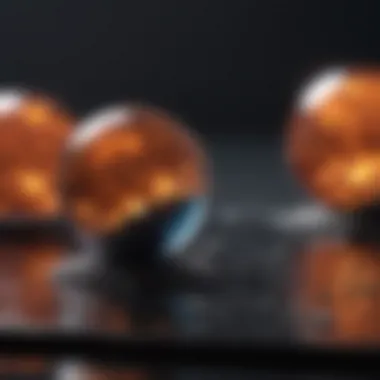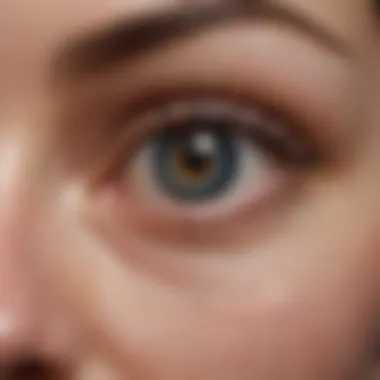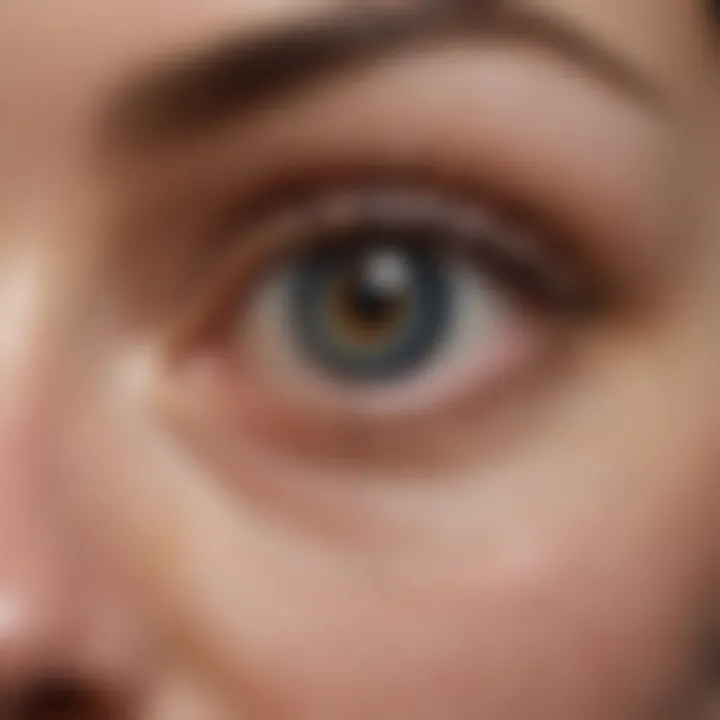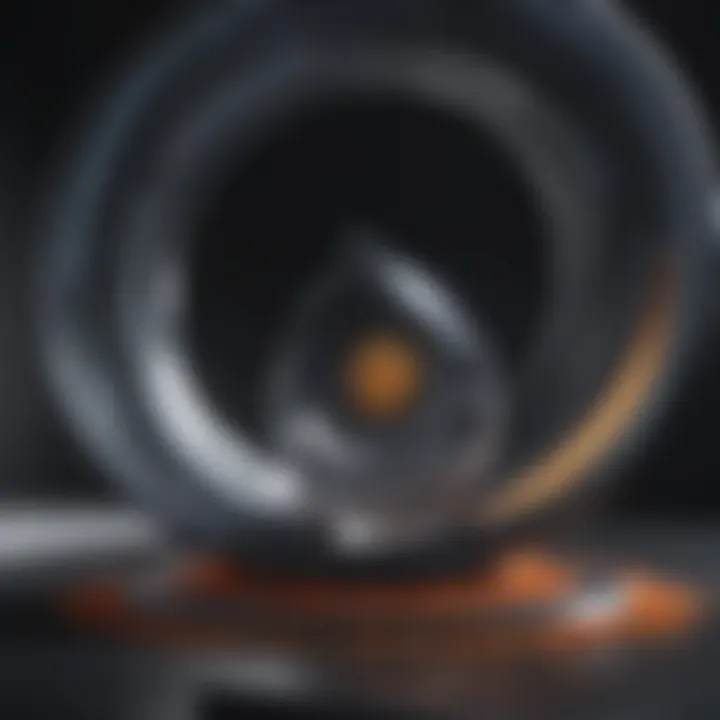Iodine Contrast CT Scan: An In-Depth Exploration


Intro
Iodine contrast CT scans have become a cornerstone in the field of medical imaging, providing essential insights into various conditions. Utilization of iodine-based contrast agents enhances the visibility of internal structures, enabling clearer diagnostic interpretations. As advances in technology emerge, understanding the essential components of these scans is critical for both healthcare professionals and patients.
The use of iodine contrast agents is primarily attributed to iodine's high atomic number, which effectively absorbs X-rays. Thus, this property is invaluable during computed tomography (CT) scans. However, while these agents significantly improve diagnostic accuracy, they also carry certain risks that warrant careful consideration.
In this article, we will delve into multiple facets of iodine contrast CT scans, discussing their applications and procedural steps as well as the implications for patient care.
By addressing both the benefits and risks, this exploration aims to equip readers—be they students, researchers, or medical personnel—with a thorough understanding of the iodine contrast CT landscape.
Preamble to Iodine Contrast CT Scans
Iodine contrast CT scans play a crucial role in modern diagnostic imaging. Their ability to enhance the visibility of internal structures allows radiologists to make accurate assessments of various medical conditions. This section introduces the foundational aspects of iodine contrast as it applies to CT scans, emphasizing its significance within the broader context of diagnostic imaging.
Definition of CT Scan
CT scan, or computed tomography, is an advanced imaging technique that utilizes X-rays and computer processing to create cross-sectional images of the body. Unlike traditional X-rays, CT scans provide more detailed information about organs, bones, and soft tissues. This enhanced detail makes CT scans invaluable, especially in emergency medicine and oncology where precise imaging can significantly impact patient outcomes.
The ability to capture high-resolution images of the body’s internal structure is one of the main advantages of CT technology.
CT technology operates by rotating around the patient, capturing multiple images from various angles. The data collected is then processed to create a comprehensive view of the selected area. This multifaceted approach is particularly beneficial when visualizing complex anatomical structures.
Importance of Contrast Agents
Contrast agents, specifically iodine-based agents, play an essential role in improving the quality of CT scans. These agents work by altering the attenuation of X-rays in different tissues, thereby enhancing the contrast between various anatomical structures. The use of iodine is particularly effective due to its high atomic number, which provides a significant difference in X-ray absorption.
The importance of contrast agents can be summarized as follows:
- Improved Visualization: They enhance the distinction between normal and abnormal tissues, facilitating better diagnosis of conditions such as tumors and vascular anomalies.
- Increased Diagnostic Accuracy: Radiologists rely on contrast-enhanced images to make informed decisions regarding diagnosis and treatment, making it indispensable in many clinical scenarios.
- Broader Applications: In addition to detecting diseases, iodine contrast agents are utilized for evaluating organ perfusion, interventional procedures, and surgical planning.
Chemical Properties of Iodine Contrast Agents
The chemical properties of iodine contrast agents are critical for their role in enhancing the clarity and detail of CT imaging. Understanding these properties helps medical practitioners in selecting the appropriate contrast medium for various diagnostic situations. Iodine, an essential element in many of these agents, has unique characteristics that are beneficial for imaging.
Molecular Composition of Iodine
Iodine contrast agents primarily consist of iodine molecules combined with other substances to create a contrast medium. The molecular structure of iodine allows for high radiopacity. This means iodine can effectively absorb X-rays, which enhances the contrast between different tissues during a CT scan. High radiopacity makes it especially useful in visualizing blood vessels and other structures that require differentiation from surrounding tissues.
The chemical formula of iodine is I2. In contrast agents, iodine is often found as part of larger molecules that enhance its solubility and distribution in the body. The presence of iodine in these compounds is what gives contrast agents their effectiveness.
Mechanism of Action in Imaging
The mechanism by which iodine contrast agents work is fundamentally linked to their ability to absorb X-rays. When the contrast medium is injected into a patient's body, iodine molecules travel through the bloodstream and into various tissues. During a CT scan, X-ray beams pass through the body. The iodine in the contrast medium absorbs these beams more than the surrounding tissues do, creating a clear outline of structures like organs and blood vessels.
The primary purpose of iodine contrast agents is to enhance the imaging quality of CT scans, thereby aiding in more accurate diagnoses.
This mechanism not only improves the visibility of vascular structures but also assists in the characterization of tumors. Tumors often have different vascular properties compared to normal tissues, and the enhanced contrast can lead to better identification and assessment.
In summary, the chemical properties, particularly the molecular composition of iodine and its mechanism of action during imaging, underscore the significance of iodine contrast agents in medical diagnostics. Their unique properties enable radiologists to obtain detailed images that are crucial for accurate diagnosis and treatment planning.
Types of Iodine Contrast Agents
The type of iodine contrast agents used in CT scans significantly influences image quality and patient experience. Selecting the right contrast medium affects the clarity of the images produced, thus impacting diagnostic outcomes. Understanding the differences among types allows clinicians to make informed decisions tailored to individual patient needs. The two primary categories of iodine contrast agents discussed here are high-osmolar versus low-osmolar agents and ionic versus non-ionic contrast materials.
High-Osmolar vs Low-Osmolar Agents
High-osmolar contrast agents contain a greater concentration of iodine per unit volume. This results in increased viscosity and a higher risk of adverse reactions. They are generally more cost-effective but come with considerations regarding patient comfort and safety. Adverse effects associated with high-osmolar agents can include more frequent occurrences of nausea or discomfort during the imaging process. These agents can also lead to vascular reactions due to their propensity to be hypertonic, causing potential issues for patients with pre-existing medical conditions.
In contrast, low-osmolar contrast agents have less iodine concentration, which makes them easier on the body and reduces the likelihood of adverse reactions. The lower osmolarity also contributes to better patient tolerance and comfort. Therefore, low-osmolar agents are ideal for a broad range of patients, notably those at risk of complications such as elderly or diabetic patients. This improved profile makes them increasingly favored in modern imaging.
Ionic vs Non-Ionic Contrast Materials
Ionic contrast materials dissociate into positively and negatively charged particles upon entering the bloodstream. This results in a high osmolarity, similar to high-osmolar agents, leading to discomfort and increased incidence of side effects such as pain and warmth at the injection site. Their use is now limited due to the advancements in non-ionic contrasts. Often, ionic materials are utilized in specific scenarios where their benefits may offset the concerns regarding side effects.
Non-ionic contrast agents, on the other hand, minimize these problems by remaining uncharged in solution. They are generally better tolerated, resulting in a lower incidence of adverse reactions. These agents are crucial in enhancing patient experience during CT scans, especially for those who may have anxiety or fears about the procedure.
In summary, the choice between high-osmolar and low-osmolar agents, as well as ionic versus non-ionic materials, is vital in the clinical decision-making process. These distinctions play a role in patient outcomes, safety, and overall satisfaction with imaging procedures.
Indications for Using Iodine Contrast in CT Scans
The usage of iodine contrast agents in CT scans is pivotal for enhancing the imaging process. These agents improve the visibility of internal structures, aiding in accurate diagnoses. Understanding the indications for their use not only enlightens clinicians on when to employ these agents but also sets forth a guideline for patient safety and optimal results.
Assessment of Vascular Structures
In the realm of medical imaging, assessing vascular structures is a critical indication for the use of iodine contrast. This application allows radiologists to visualize blood vessels in detail. With iodine enhancing the images, it becomes easier to detect conditions such as aneurysms, stenosis, and thrombi. The clarity provided by iodine contrast helps in determining blood flow and vessel integrity.
In cases like a suspected pulmonary embolism, a CT pulmonary angiogram is often used, which requires iodine contrast for visualizing the pulmonary arteries. The result is a rapid and precise assessment which directly impacts patient management, potentially saving lives.


Characterization of Tumors
Another major indication for using iodine contrast in CT scans is the characterization of tumors. Tumors often require distinct imaging features to differentiate between various types, such as benign versus malignant growths. Iodine contrast helps in enhancing the borders of tumors, improving the delineation of tumorous tissues from healthy tissues.
By utilizing contrast-enhanced CT scans, radiologists can gather crucial information regarding the size, shape, and vascularization of the tumor. This data is vital for staging cancer, planning surgical interventions, and assessing responses to treatment. The ability to visualize changes in tumor characteristics over time enhances not only diagnostic but also therapeutic strategies, leading to more personalized patient care.
"Iodine contrast agents are key in enhancing CT imaging, crucial for detailed assessments and accurate diagnoses."
The deployment of iodine contrast in these indications underscores its significance in clinical practice. A comprehensive understanding of when and how to utilize these agents will lead to better health outcomes and innovations in treatment methodology.
The benefits of employing iodine contrast are profound, making it an invaluable tool for modern imaging techniques.
Procedure of Iodine Contrast CT Scans
The procedure for iodine contrast CT scans is a crucial aspect of this imaging technique. It encompasses a series of steps that ensure the successful use of contrast agents, which in turn enhances the diagnostic capabilities of the scan. It is essential to understand these steps, as they not only affect the quality of the images produced but also the safety and comfort of the patient.
Pre-Scan Preparations
Proper preparation before a CT scan using iodine contrast is vital. These preparations aim to minimize potential risks and ensure accurate imaging results.
- Patient History Evaluation: Medical staff must gather a comprehensive patient history. This information includes previous allergic reactions to iodine or contrast agents, current medications, and any underlying health conditions, notably kidney problems.
- Renal Function Assessment: Given the potential impact on kidney function, evaluating renal status is important. This can involve blood tests to check creatinine levels. Patients with decreased kidney function may require special considerations.
- Hydration: Encouraging adequate hydration before the scan is generally recommended. This can help in reducing the risk of contrast-induced nephropathy.
- Informing the Patient: It is also crucial to inform patients about the procedure, what to expect during the scan, and any sensations they may experience, such as warmth or a metallic taste when the contrast is administered.
In summary, thorough pre-scan preparations are necessary to select the right candidates for iodine contrast use, reduce risks, and optimize imaging accuracy.
Administration of Contrast Medium
The administration of the iodine contrast medium is a tailored process that hinges on several factors, including the patient's health status and the specific imaging goals.
- Route of Administration: Iodine contrast agents can be administered through an intravenous injection or, in some cases, through an oral route. IV administration is more common for CT scans.
- Timing: This procedure typically entails injecting the contrast medium just before or during the scanning process. This synchronization is vital to ensure that the contrast agent circulates through the bloodstream, enhancing the visualization of blood vessels and tissues.
- Monitoring: During administration, monitoring for any immediate allergic reactions is crucial. Medical personnel remain vigilant to manage any adverse effects swiftly.
- Post-Administration Care: After the scan, patients may receive guidance to drink fluids to help flush out the contrast material from their systems.
The procedure is essential not just for enhancing image quality but also for ensuring patient safety.
The correct administration of iodine contrast results in clearer images and significantly aids in clinical diagnoses.
Interpreting Results from Iodine Contrast CT Scans
Interpreting the results of iodine contrast CT scans is a crucial aspect of medical imaging. The analysis of these imaging findings provides valuable insights into a patient's health condition. Radiologists play a significant role in this evaluation, as they translate the visual information into clinically relevant data. A precise interpretation can affect diagnosis and subsequent treatment decisions profoundly.
Understanding Imaging Findings
The imaging findings from iodine contrast CT scans provide a detailed view of internal structures. The contrast agent enhances visibility, making blood vessels and organs more discernible. Usually, these images are assessed for abnormalities such as tumors, blockages, or unusual tissue patterns. Radiologists compare the enhanced images against standard norms to detect any deviations.
Key aspects during the evaluation include:
- Contrast Enhancement: Areas that uptake the iodine indicate increased blood flow or abnormal tissue behavior.
- Density Differences: Variations in tissue density can show the presence of lesions or other pathological conditions.
- Vascular Structures: Enhanced imaging can clearly delineate arteries and veins, allowing for assessment of conditions like aneurysms.
Understanding these fundamental components allows healthcare professionals to formulate accurate diagnoses, thus improving patient outcomes.
Role of Radiologists in Diagnosis
Radiologists are the primary interpreters of iodine contrast CT scan images. Their expertise is vital for discerning the subtleties within the scans that may not be apparent to others. After reviewing the scans, radiologists compile reports that detail their findings and opinions.
Their responsibilities include:
- Detailed Analysis: They examine the images for signs of disease, anatomical anomalies, or abnormalities.
- Clinical Correlation: Radiologists collaborate with referring physicians to ensure the images are interpreted in the context of the patient’s history and symptoms.
- Patient Safety: Monitoring for potential complications resulting from iodine contrast administration and ensuring follow-up if necessary.
- Guiding Further Testing: Based on the results, radiologists may recommend additional imaging or tests to confirm findings.
The impact of a radiologist's interpretation can lead to timely and accurate patient care, underscoring the importance of this profession in the continuum of healthcare.
Potential Risks and Side Effects of Iodine Contrast
Understanding the potential risks and side effects associated with iodine contrast agents is essential in the context of CT scans. The use of contrast agents enhances the quality of images obtained, but it is important to balance this benefit against possible adverse effects. Areas of concern include allergic reactions and impacts on kidney function. Knowing these issues helps healthcare providers make informed decisions about patient management.
Allergic Reactions to Iodine Contrast
Allergic reactions to iodine contrast agents are not uncommon. The severity can vary from mild symptoms like itching and rashes to more significant problems, such as anaphylaxis, which can be life-threatening. The risk of reactions is higher in individuals with a history of allergies, particularly to iodine or seafood. About 3% of patients may experience some sort of allergic response. This is relevant as it necessitates careful pre-contrast screening to identify anyone who may be more susceptible.
Healthcare professionals often perform a thorough patient history review to assess the risk of an allergic reaction. It is advisable for patients with known sensitivities to discuss alternative imaging options or premedication strategies to mitigate these risks.
Impact on Kidney Function
The impact of iodine contrast on kidney function is another critical aspect. Use of iodine-based contrast can lead to Contrast-Induced Nephropathy (CIN), a condition where kidney function deteriorates after exposure to the agent. This is particularly concerning in patients with pre-existing kidney conditions, or who are diabetic. The rise in creatinine levels in the blood is an indication of renal impairment.
To safeguard against this issue, practitioners often assess kidney function through serum creatinine testing before administering contrast. Patients may also receive hydration before and after the procedure to lower the risk of CIN. Understanding the balance between the diagnostic benefits of enhanced imaging and the potential for renal side effects ensures that patient safety remains a priority.
"Prevention is always better than cure; knowing patient history can save lives."
Assessing these risks and implementing appropriate management strategies can significantly enhance the safety of iodine contrast use in medical imaging.
Management of Patients with Iodine Sensitivity


The management of patients with iodine sensitivity is a crucial aspect of utilizing iodine contrast agents in CT scans. Iodine-based contrast media are widely used in medical imaging to enhance the detail of scanned images. However, some patients exhibit sensitivity to iodine, which can lead to allergic reactions or other adverse effects. Recognizing this concern is vital for ensuring patient safety and optimizing imaging outcomes.
In clinical practice, effective management strategies are essential to mitigate risks associated with iodine sensitivity. These strategies involve several key elements:
- Risk Assessment: Understanding each patient's medical history is the first step. Clinicians should evaluate previous reactions to iodine contrast agents or other allergies. Knowledge of the patient's allergy history helps to guide decisions regarding the use of iodine contrast.
- Patient Education: Informing patients about potential risks and symptoms of allergic reactions is essential. Clear communication can alleviate anxiety and promote informed decision-making.
- Alternative Strategies: Knowing alternative imaging techniques is critical for patients with confirmed iodine allergies.
By adopting these practices, healthcare providers can enhance both patient safety and the efficacy of diagnostic imaging.
Pre-Contrast Screening Procedures
Pre-contrast screening procedures are fundamental to the safe administration of iodine contrast agents in patients who may have iodine sensitivity. These procedures primarily aim to identify individuals at risk of adverse reactions. The screening process typically includes:
- Detailed Medical History: Clinicians gather thorough information regarding the patient's past experiences with contrast media. Details about any known allergies, particularly to iodine or seafood, are particularly valuable.
- Physical Examination: A physical checkup can reveal potential underlying health issues that might increase the risk of allergies.
- Allergy Assessment: Specific allergy assessment tests can determine sensitivity to iodine. Such tests guide physicians in deciding the best course of action.
These procedures help to prevent complications during imaging by ensuring that only suitable candidates receive iodine contrast agents, paving the way for a safer imaging experience.
Alternative Imaging Techniques
For individuals identified as having iodine sensitivity, alternative imaging techniques can provide necessary diagnostic insights without the use of iodine contrast agents. Some notable alternatives include:
- MRI with Gadolinium-Based Contrast Agents: This technique utilizes gadolinium, which is generally considered safe for patients with iodine allergies. Gadolinium enhances MRI images effectively while minimizing the risk of allergic reactions.
- Ultrasound with Contrast Agents: Ultrasound technology has advanced significantly, allowing the use of specific contrast agents. This can reduce the reliance on iodine-based contrasts, especially in vascular imaging.
- CT without Contrast: Non-contrast CT scans can still provide useful information. Although not as detailed as contrast-enhanced scans, they can be valuable for certain diagnoses.
Exploring these alternatives is essential for medical professionals. Proper assessment and application can lead to effective imaging while ensuring patient safety. Overall, the management of iodine sensitivity is paramount in clinical practice, fostering a proactive approach to patient care and imaging quality.
Alternatives to Iodine Contrast Agents
The topic of alternatives to iodine contrast agents is significant in the field of medical imaging. As more patients present with iodine sensitivities or other contraindications, understanding alternative agents becomes critical. These alternatives can enhance imaging techniques while minimizing risks associated with iodine contrast, providing crucial diagnostic information for healthcare professionals. The exploration of these alternatives also addresses the need for safe and effective imaging practices in clinical settings.
Gadolinium-Based Agents
Gadolinium-based agents are widely used as a substitute for iodine contrast in certain imaging studies. These agents contain gadolinium, a rare earth element known for its ability to enhance the quality of magnetic resonance imaging (MRI). Unlike iodine contrast, gadolinium is less likely to cause allergic reactions. However, careful consideration is necessary regarding their effects on patients with kidney conditions, particularly those with severe renal impairment.
Using gadolinium can improve the contrast in vascular studies and soft tissue characterization, offering a valuable imaging solution. These agents are particularly favorable for patients who have known allergies to iodine or a history of contrast-induced nephropathy. However, the implementation of gadolinium-based agents must involve thorough patient screening and education on potential risks.
Ultrasound Contrast Agents
Ultrasound contrast agents represent another viable alternative to iodine-based contrasts. These agents enhance the echogenicity of structures, improving ultrasound imaging's sensitivity and specificity. Unlike traditional contrast agents used in CT scans, ultrasound contrast agents typically contain microbubbles or gas-filled particles. They are known for their excellent safety profile and low incidence of adverse reactions.
Ultrasound contrast has applications in various fields, including cardiology and hepatology, where real-time imaging is essential. The primary benefit is that these agents provide a contrast enhancement without the concerns tied to iodine sensitivity or kidney function impairment. Thus, for individuals needing imaging but facing limitations due to iodine contrast risks, ultrasound contrast provides a promising solution.
The choice of contrast agent should always consider patient-specific factors, underlying conditions, and the imaging requirements.
In summary, both gadolinium-based agents and ultrasound contrast agents offer significant advantages as alternatives to iodine contrast agents in medical imaging. They allow for continued diagnostic capability while addressing safety concerns associated with iodine-based products. This diversification in imaging options helps meet the varying needs of patients and enhance the overall quality of medical care.
Future Trends in Contrast Imaging
The landscape of contrast imaging, particularly with iodine-based agents, is rapidly evolving. This section reflects on future trends that are poised to shape diagnostic practices and improve patient outcomes. As technology progresses, several key elements stand out, including the advent of novel agents, enhanced imaging techniques, and critical considerations related to safety and efficacy.
Advancements in Imaging Technology
Advancements in imaging technology have transformed how contrast agents are utilized. The shift towards faster and more precise CT scans enhances diagnostic accuracy. Innovations like spectral imaging allow for better detection of abnormalities and reduce the need for repeat scans. Increased spatial and temporal resolution is another notable improvement, providing clearer images for even subtle pathologies. Moreover, integrating artificial intelligence algorithms into imaging can identify patterns that might be missed by human eyes.
Features of these advancements include:
- High-speed scanners capable of conducting scans in less time
- Three-dimensional reconstruction capabilities for comprehensive analysis
- Dual-energy CT to differentiate between materials based on their energy levels, improving specificity for differentiating pathologies.
The implications of these technological strides are profound. They not only streamline processes but also enhance the quality of care patients receive. Getting more accurate images in less time can aid in quicker diagnosis and intervention, ideally leading to improved prognosis for various conditions.
Research on Novel Contrast Agents
Research efforts focused on developing novel contrast agents are gaining momentum. The search aims to minimize the adverse effects associated with traditional iodine contrast materials. Alternatives such as gadolinium-based agents and oxygen-based agents are being explored. These substances often present a lower risk of nephrotoxicity and other allergic reactions. Their development aligns with the increasing need for safer imaging solutions, especially for vulnerable populations like patients with renal impairment.
Another promising avenue is smart contrast agents that respond to specific stimuli in the body. These agents highlight regions of interest more effectively and reduce background noise in imaging processes. Research indicates that such innovations could provide enhanced contrast in areas such as oncology and vascular imaging.
"Developing new contrast materials introduces the potential for safer, more effective imaging techniques, promising better patient outcomes in the arena of medical diagnostics."
Ethical Considerations in Contrast Use
The use of iodine contrast agents in CT scans raises important ethical considerations that practitioners must recognize and address. These considerations hinge upon patient autonomy, safety, and the professional responsibility of healthcare providers. Understanding these factors is crucial, as they directly impact clinical practice and patient outcomes.
Informed consent and patient education play a key role in ethical considerations. Patients must be aware of the procedures and potential risks involved when iodine is used in imaging. It is not simply a matter of asking for permission; it involves thorough communication about what the contrast agent entails. Practitioners should ensure that patients comprehend the benefits and risks before proceeding. This communication fosters a sense of trust and respect, which is essential for a healthy therapeutic relationship.
Ethical practice also demands transparency regarding alternatives to iodine contrast. In certain cases, patients might have contraindications to using iodine-based materials, which necessitate a discussion of other imaging modalities that could be equally effective. By providing all available options, healthcare professionals uphold their ethical duty to act in the patient's best interests.
Moreover, ethical considerations extend to how information about the use of contrast agents is shared within medical communities and to patients. This should include accurate data on any potential side effects or complications. Informed decision-making is paramount in clinical settings, and patients must be confident that they are fully aware of what they consent to.
"Informed consent is not just a legal formality; it is a fundamental aspect of patient autonomy and ethical medical practice."


Informed Consent Practices
Informed consent practices involve a systematic approach that ensures patients are adequately informed prior to undergoing procedures involving iodine contrast. The essence of informed consent is twofold: patients should not only receive information about the procedure but also have the opportunity to ask questions and clarify any uncertainties. This process typically includes explaining the rationale for using the iodine contrast agent, how it is administered, and any anticipated benefits for their diagnosis or treatment.
Practitioners should also outline the potential side effects of iodine contrast, including allergic reactions and impacts on kidney function. Patients must know that they have the right to refuse or defer the procedure if they feel uncomfortable.
Discussion of Benefits vs Risks
When weighing the benefits against the risks, it becomes essential to contextualize the information presented. Iodine contrast agents play a pivotal role in enhancing the diagnostic imaging process, providing clearer and more detailed images. Such clarity can significantly aid in the accurate diagnosis of various conditions, ranging from trauma to oncological assessments.
However, the risks associated with iodine contrast cannot be dismissed. Patients may experience allergic reactions, ranging from mild skin rashes to severe anaphylactic responses. Additionally, iodine contrast can have implications for those with existing renal conditions, necessitating careful evaluation of patients' kidney function prior to contrast administration.
In summary, ethical considerations surrounding iodine contrast use ensure that patient safety and autonomy remain at the forefront of medical imaging practices. Professionals must navigate the terrain of informed consent with diligence and transparency, weighing the substantial benefits of enhanced imaging against the potential risks. This approach is fundamental in fostering an ethical and patient-centered healthcare environment.
Regulatory Standards in Medical Imaging
Regulatory standards in medical imaging play a crucial role in ensuring the safety and effectiveness of imaging procedures, particularly those involving iodine contrast agents. These standards guide healthcare practitioners in the appropriate usage of contrast materials, helping mitigate potential risks and enhancing patient care. Compliance with established guidelines not only fosters trust between patients and healthcare providers but also promotes a high degree of accuracy in diagnostic imaging. Understanding these regulations is essential for any stakeholder in the medical imaging field.
Guidelines for Safe Use
The guidelines for the safe use of iodine contrast agents are developed to optimize patient outcomes while minimizing adverse effects. These encompass various protocols, such as:
- Pre-Contrast Assessment: Reviewing the patient's medical history for allergies or kidney function issues.
- Dosing Protocols: Following manufacturer recommendations and adjusting doses based on patient demographics.
- Monitoring During Administration: Observing patient responses closely to identify allergic reactions or other complications.
- Post-Procedure Care: Ensuring hydration and monitoring any delayed reactions, especially in patients with compromised renal function.
These procedures ensure that the benefits of enhanced imaging do not come at an unnecessary cost to patient safety. Each imaging center must adapt these guidelines to align with both local regulations and the latest scientific research.
Role of Health Organizations
Health organizations are pivotal in the establishment and enforcement of regulatory standards in imaging. Their responsibilities include:
- Creating Standards: Developing evidence-based protocols that harmonize practices across institutions.
- Education and Training: Providing resources and training for healthcare professionals on best practices and new technologies.
- Monitoring Compliance: Conducting audits and assessments to ensure adherence to safety regulations.
- Research and Development: Supporting studies aimed at improving contrast agents and imaging techniques to enhance safety profiles.
Health organizations like the American College of Radiology and the Radiological Society of North America regularly publish guidelines that reflect the evolving landscape of medical imaging. Through their efforts, the industry is pushed towards continuously improving safety and efficacy outcomes for patients undergoing iodine contrast CT scans.
"Regulatory standards are not merely a formality; they are vital to patient safety and diagnostic accuracy in medical imaging."
In summary, adhering to regulatory standards ensures that iodine contrast agents are used effectively and safely, fostering an environment where patient care is the utmost priority.
Patient Experiences and Perspectives
Patient experiences and perspectives play a crucial role in understanding the full impact of iodine contrast CT scans. They provide insights beyond the purely technical aspects of the procedure. These narratives are valuable for both clinicians and patients. Real-life accounts can shape expectations, inform decision-making, and improve overall patient care.
Moreover, personal stories often highlight the emotional context surrounding medical imaging. Patients may have fears or anxieties regarding scans and contrast usage. Addressing these feelings can enhance patient satisfaction and compliance with medical protocols.
Additionally, perspectives from patients can drive improvements in the administration of contrast agents. Feedback from individuals who have undergone the procedure can help healthcare professionals refine standard practices. This connection is essential as it bridges the gap between medical advice and actual patient experience.
Personal Accounts of Contrast Use
Personal accounts of contrast use reveal a diverse range of responses to the procedure. Some patients report feeling anxious before the scan, particularly concerning the contrast agent itself. Reactions can vary widely, from mild discomfort to severe allergic responses. For example, one patient described feeling a warm sensation and a metallic taste immediately after receiving the iodine contrast. This sensation, while alarming to some, is usually temporary and represents normal physiological reactions.
Other narratives focus on the perceived benefits of using iodine contrast, such as clearer images leading to accurate diagnoses. Patients often express relief after receiving a prompt diagnosis based on the scan results. Moreover, individuals with existing health conditions may feel a heightened appreciation for how iodine contrast assists in monitoring their situation.
In the context of shared experiences, patients may discuss how they prepared for the procedure. Many highlight the importance of discussing fears with healthcare providers to help ease anxiety.
Patient Education and Awareness
Patient education and awareness are critical elements surrounding iodine contrast CT scans. Understanding the procedure, the role of contrast agents, and the related risks can improve patient comfort and cooperation. Educational materials can demystify the process, presenting clear, straightforward information about what to expect during the scan.
Effective education includes addressing potential side effects such as allergic reactions. It is important for patients to know what symptoms to watch for post-scan, so they can seek medical attention if necessary. Providers should emphasize communication, ensuring that patients feel empowered to ask questions about their care.
Additionally, informing patients about the benefits associated with contrast use is key. Many patients may not realize how significantly iodine contrast can enhance imaging quality. This awareness helps foster a more positive view of the overall procedure and the healthcare experience.
In summary, patient experiences and perspectives provide invaluable context for iodine contrast CT scans. By emphasizing education and understanding the individual narratives, healthcare professionals can significantly enhance patient care and outcomes.
Culmination and Clinical Implications
Iodine contrast CT scans hold significant place in modern medical imaging. Their primary function is to provide clearer images that enhance the visibility of structures within the body. This improvement is crucial for accurate diagnosis and treatment planning. Understanding the implications of using iodine contrast is essential for both practitioners and patients.
Clinical significance is multifaceted. For one, iodine contrast significantly increases the accuracy of diagnoses. It aids in identifying tumors, vascular diseases, and other abnormalities that might go unnoticed in standard scans. The implications extend beyond mere imaging; better diagnosis translates to more effective treatment paths.
Moreover, patient safety remains paramount. Knowledge surrounding the risks associated with iodine contrast, such as allergic reactions and nephrotoxicity, ensures that healthcare providers can mitigate potential complications. Establishing appropriate screening measures and having emergency protocols in place is therefore crucial.
To summarize, the use of iodine contrast CT scans is embedded in a clinical landscape that values precision, safety, and the advancement of medical practices. A nuanced understanding of these aspects is essential for anyone involved in healthcare.
Summarizing Key Points
- Enhancement of Imaging Quality: Iodine contrast agents significantly improve diagnostic accuracy, making them essential in modern imaging.
- Risks Awareness: Healthcare professionals must recognize and manage potential side effects such as allergies and kidney function impairment.
- Patient Management: Preparations and follow-up care are instrumental in ensuring patient safety during and after scans.
- Technological Integration: Advancements in imaging technology continue to evolve, with new research paving the way for innovative uses of iodine contrast.
Future Directions for Research
Research in iodine contrast CT scans is evolving. The focus is shifting toward understanding the long-term effects of contrast agents on vulnerable populations. Studies might explore ways to minimize adverse reactions, especially for patients with previous sensitivities.
Several key areas show promise for future research:
- Alternative Agents: Investigating alternative contrast materials that are safer for patients, particularly those allergic to iodine.
- Dosing Guidelines: Establishing more precise dosing guidelines can enhance safety and efficacy in various clinical scenarios.
- Technological Innovations: Developments in imaging technology may allow for reduced dosage of contrast agents while maintaining image quality.







